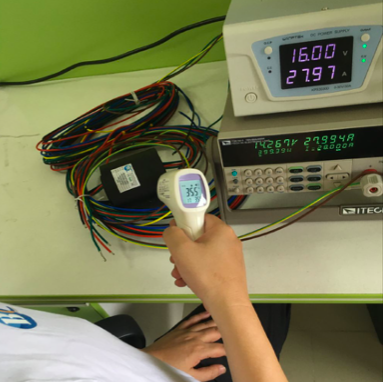How to Determine the Quality of Through Hole Slip Ring?
Overview
Learning how to determine the quality of through hole slip rings can help us find the most suitable slip rings. It includes a number of checks and tests:
- Appearance Inspection: This is the most basic inspection method. We ensure that the size of the through hole slip ring meets the standard by visual inspection or using measuring tools. And after removing the damaged, deformed, and worn defective products, we strictly check according to the technical drawings.
- Signal Transmission Interference Test: Technicians use professional equipment such as signal generators, spectrum analyzers, oscilloscopes, and electrostatic discharge generators to check whether the slip ring can transmit signals stably. During this process, the through hole slip ring should not generate obvious noise, distortion, and interference. This test can ensure the accuracy of the slip ring signal in a complex electromagnetic environment. This is important for high-precision industries such as medical and aerospace.
- Electrical Continuity: The electrical continuity of the through hole slip ring means that the current can be continuously and stably conducted in its various conductive channels during the rotation of the slip ring. This includes contact resistance measurement, loop resistance test, and voltage drop test. For example, we can use a micro-ohmmeter or a digital multimeter's resistance range to measure the electrical continuity of the slip ring. When the conductive ring is intact, its resistance value should be close to zero (generally less than 0.1 ohms)
- Insulation Resistance: Insulation resistance can measure the insulation performance of the slip ring. ByTune applies a certain DC voltage between the conductive part and the insulating part of the slip ring, then measures the generated current and calculates the insulation resistance value. Among them, the insulation resistance value of our cap-type slip ring can reach ≥1000mΩ/500VDC for the power circuit and ≥500mΩ/500VDC for the signal circuit, and can be customized according to needs.
- Contact Resistance: Contact resistance is the resistance at the contact point between the brush and the conductive ring. Under normal working current, the contact resistance of the through-hole slip ring should be less than 50 milliohms, so that when a large current (such as 10A) is transmitted, the heat generated by the contact resistance (according to P = I²R) is relatively small. Lower contact resistance can reduce the heating and energy loss of the conductive parts of the slip ring.
- Temperature Test: We use thermocouples or infrared thermal imagers to measure, and the temperature rise should not exceed the specified value. In addition, during overload tests (such as 1.5 times the rated current), the temperature rise should also be within the safe range that the material can withstand.
- Mechanical Durability: This includes detecting aspects such as the wear resistance, rotational speed, and stability of the slip ring. They are evaluated through life tests. For example, we let the through-hole slip continuously rotate at the rated speed (such as 3000 rpm) for a certain period of time (such as 10,000 hours) and observe the wear of the brush and the performance changes of the slip ring. The standard service life of ByTune's slip rings is 80,000,000 revolutions.
- Setting Up and Running the Test System: Running the test means testing the various performances of the slip ring in the actual operating state after the slip ring is installed. You need to set it up initially to run the required test sequence. You can generate reports with custom options for charts and other functions. This can help us detect whether the slip ring can work stably,
- Certifications: Verifying whether the slip ring complies with relevant industry standards and certifications is our way to judge its quality and compatibility. This may include certifications such as UL, IEC, and CE. These standards prove that the slip ring will not cause safety hazards under normal use and in some special cases (such as short circuits and overloads).
Conclusion
Now we already know the effective ways to confirm the quality of through-hole slip rings. If you want to know more details to test them, it is all in ByTune's article "How to Test a Slip Ring?".












评论
发表评论